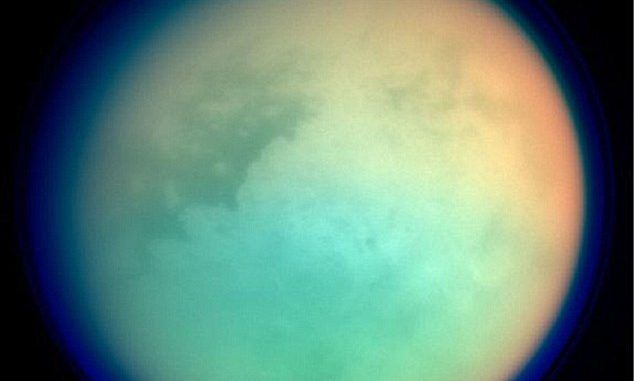
Via an article in The Daily Mail: “It is an incredible image of oceans on another world.
Nasa today released this incredible mosaic showing the sun glinting off polar seas on titan, one of Saturn’s moons.
This mirror-like reflection, known as the specular point, is in the south of Titan’s largest sea, Kraken Mare, just north of an island archipelago separating two separate parts of the sea.

BYPASS THE CENSORS
Sign up to get unfiltered news delivered straight to your inbox.
You can unsubscribe any time. By subscribing you agree to our Terms of Use

This near-infrared, color mosaic from NASA’s Cassini spacecraft shows the sun glinting off of Titan’s north polar seas. This mirror-like reflection, known as the specular point, is in the south of Titan’s largest sea, Kraken Mare, just north of an island archipelago separating two separate parts of the sea.
The near-infrared, color mosaic from NASA’s Cassini spacecraft shows the sun glinting off Titan’s north polar seas.
While Cassini has captured, separately, views of the polar seas (seePIA17470) and the sun glinting off of them (see PIA12481 and PIA18433) in the past, this is the first time both have been seen together in the same view.

The sunglint, also called a specular reflection, is the bright area near the 11 o’clock position at upper left.
This particular sunglint was so bright as to saturate the detector of Cassini’s Visual and Infrared Mapping Spectrometer (VIMS) instrument, which captures the view,’ Nasa said.
‘It is also the sunglint seen with the highest observation elevation so far — the sun was a full 40 degrees above the horizon as seen from Kraken Mare at this time — much higher than the 22 degrees seen in PIA18433.’

The southern portion of Kraken Mare (the area surrounding the specular feature toward upper left) displays a ‘bathtub ring’ – a bright margin of evaporate deposits – which indicates that the sea was larger at some point in the past and has become smaller due to evaporation.
The deposits are material left behind after the methane & ethane liquid evaporates, somewhat akin to the saline crust on a salt flat.
The highest resolution data from this flyby — the area seen immediately to the right of the sunglint — cover the labyrinth of channels that connect Kraken Mare to another large sea, Ligeia Mare.
Ligeia Mare itself is partially covered in its northern reaches by a bright, arrow-shaped complex of clouds.
Titan has a global circulation pattern in which warm air in the summer hemisphere wells up from the surface and enters the stratosphere, slowly making its way to the winter pole. There, the air mass sinks back down, cooling as it descends, which allows the stratospheric methane clouds to form.
The clouds are made of liquid methane droplets, and could be actively refilling the lakes with rainfall.
The view was acquired during Cassini’s August 21, 2014, flyby of Titan, also referred to as ‘T104’ by the Cassini team.
The view contains real color information, although it is not the natural color the human eye would see. Here, red in the image corresponds to 5.0 microns, green to 2.0 microns, and blue to 1.3 microns.
These wavelengths correspond to atmospheric windows through which Titan’s surface is visible.
The unaided human eye would see nothing but haze, as in PIA12528.


